Sunday, December 29, 2024. Annette’s News Roundup.
Even before 2026, good things may happen to weaken Trump and protect our Democracy.
A Razor-Thin House Majority Creates Headaches for Republicans.
They won, but barely.
Republicans held on to control of the House of Representatives in November by one of the thinnest margins in the country’s history—even smaller than in the current Congress—a result that will have them walking a tightrope again for the next two years. The drama starts next week when the party tries to elect a new speaker on the first day of the new session, with fresh grumblings about leadership setting the stage for an unpredictable vote.
Republicans won 220 seats to Democrats’ 215. One planned vacancy—that of former Rep. Matt Gaetz, who was elected to another term but said he won’t take office—will reduce Republicans to 219 when lawmakers reconvene on Jan. 3. Two resignations of lawmakers set to join the Trump administration—Reps. Elise Stefanik and Mike Waltz—will temporarily reduce GOP numbers to 217 later in January before special elections are held. President-elect Donald Trump starts his second term on Jan. 20.
While Republicans will have full control of Congress and the White House, the wafer-thin cushion in the House means any small handful of Republican defectors could trip up the GOP agenda by holding out for their leaders or their own terms. As the past two years have shown, it also means that a run of bad luck for Republicans—such as health setbacks or a string of resignations—could eat into the margin.
“We know how to work with a small majority; that’s our custom now,” House Speaker Mike Johnson (R., La.) told reporters earlier this month. “This is a team effort and we’ve got to all row in the same direction.”
At the extreme, Republicans could surrender the majority by attrition before the next election, something that actually happened in 1931, when Republicans lost a two-seat majority midway through then-President Herbert Hoover’s term….
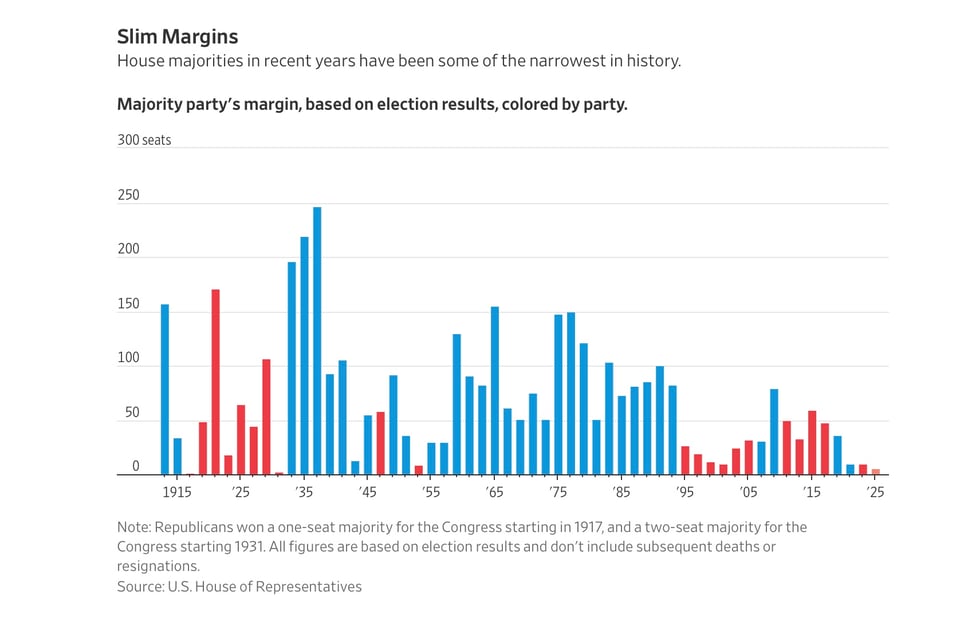
“I don’t think that there’s any reason to believe that the Republican membership is completely unified on lots of issues,” said Andy Ballard, an assistant professor of political science at Florida State University.
The first test of the majority’s alignment will be when the House picks a speaker—Johnson is seeking re-election—and passes a rules package. Both require a majority of the full House.
In early 2023, when Republicans held 222 seats to Democrats’ 212, the chamber took four days and 15 ballots to elect a speaker due to opposition to Kevin McCarthy (R., Calif.) from some hard-line Republicans. In exchange for the holdouts’ support, McCarthy was forced to make concessions, including a new rule that empowered any single lawmaker to force a vote on ousting the speaker. Critics took another run at McCarthy later that year, with Gaetz engineering his removal, joined by Democrats.
Johnson now faces his own challenges to keep the speakership, after a wrenching fight earlier this month over a year-end government funding bill. Rep. Thomas Massie (R., Ky.) said he won’t support Johnson, and other House Republicans have said they want to possibly look at other candidates. Rep. Victoria Spartz (R., Ind.) said that she would stop caucusing with the GOP “until I see that Republican leadership in Congress is governing.”
“It’s important for us to stay calm, stay present at all times, because the margin is going to be extremely narrow during the first days of the new administration,” said House Minority Leader Hakeem Jeffries (D., N.Y.) on MSNBC.
The experience of the past two years shows how volatile thin majorities can be. After starting 2023 with a 10-seat margin in the House, Republicans saw their majority temporarily whittled away to a four-seat margin this past spring before expanding again when seats were filled. Republicans ended up with an eight-seat advantage, at 219-211.
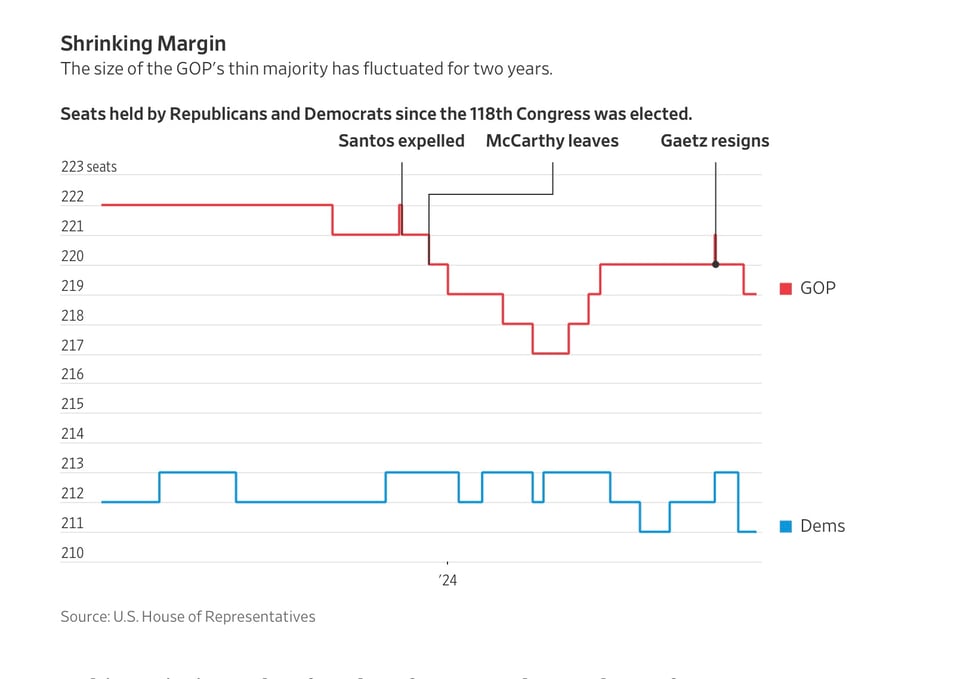
A thin majority makes for a lot of guesswork. Members of Congress regularly miss votes for an array of reasons including illness, travel and other obligations.
In February, Republicans initially failed in their effort to impeach Department of Homeland Security Secretary Alejandro Mayorkas as a protest over President Biden’s immigration record.
Rep. Al Green (D., Texas), recovering from emergency abdominal surgery, surprised Republicans by arriving to vote in a wheelchair still in pain and wearing hospital-issued anti-slip socks. He cast the final opposing vote to sink the effort. One week later, Republicans succeeded in impeaching Mayorkas after House Majority Leader Steve Scalise (R., La.), returned to the Hill following cancer treatments.
This Congress, both parties can expect further resignations and health issues.
“Republicans do have a math problem, but they shouldn’t lose a majority,” said Erin Covey, an analyst at the nonpartisan Cook Political Report, noting that multiple vacancies would have to occur in a short time span to flip the chamber even temporarily. (WSJ).
Breakin’ News. There goes the first of the GOP Congressmen 👇
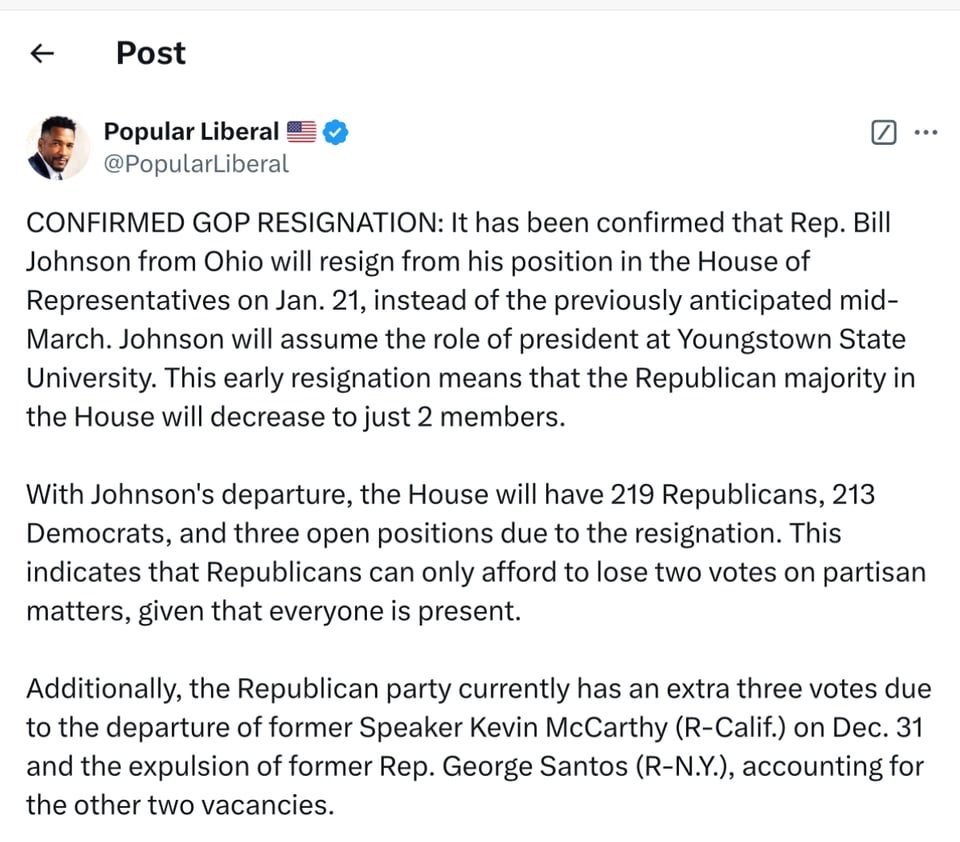
For now, enjoy Trump Support Splintering.
It gives Democracy breathing space.
Predictably, for now, Trump seems to be siding with the group that promises to make him the most money. Musk and the Silicon Valley tech boys. Will that change?
He no longer needs the White Supremacists who voted him in.
A third group of supporters is also resisting Trump’s priorities-the more traditional Republican members (so-called Conservatives) in both the House and in the Senate. They support NATO, Ukraine and traditional American foreign policy.
Some of these may simply vote against Trump when he needs votes to pass his bills. Others may resign or retire, hurting control of the House or Senate or even ending GOP control in the House before the 26 midterm elections.
Civil war has broken out within the MAGA Republicans by Heather Cox Richardson. December 27, 2024.

On the one side are the traditional MAGAs, who tend to be white, anti-immigrant, and less educated than the rest of the U.S. They believe that the modern government’s protection of equal rights for women and minorities has ruined America, and they tend to want to isolate the U.S. from the rest of the world. They make up Trump’s voting base.
On the other side are the new MAGAs who appear to have taken control of the incoming Trump administration. Led by Elon Musk, who bankrolled Trump’s campaign, the new MAGA wing is made up of billionaires, especially tech entrepreneurs, many of whom are themselves immigrants.
During the campaign, these two wings made common cause because they both want to destroy the current U.S. government, especially as President Joe Biden had been using it to strengthen American democracy. Traditional MAGA wants to get rid of the government that protects equality and replace it with one that enforces white male supremacy and Christianity. New MAGA—which some have started to call DOGE, after the Department of Government Efficiency run by Musk and pharmaceutical entrepreneur Vivek Ramaswamy—wants to get rid of the government that regulates business, especially technology, and protects American interests against competition from countries like China.
Their shared commitment to the destruction of the current government is about the only overlap between these two factions.
With the campaign over, traditional MAGA and DOGE are ripping apart. Trump sparked the fight when he announced on Sunday, December 22, that he would appoint Musk associate Sriram Krishnan, who was born in India, as a senior policy advisor on artificial intelligence.
On Monday, MAGA activist Laura Loomer criticized Trump’s choice of Krishnan. Loomer was in Trump’s inner circle until three months ago, when her anti-immigrant tirades made Trump campaign staff worry she would cost Trump votes and forced her out of his public schedule. Loomer noted that Krishnan wants to remove the cap on green cards for workers from certain countries.
Krishnan has also called for making it easier for skilled foreign workers to come to the U.S. on H-1B temporary visas. These programs are important to the technology sector, but critics say they enable companies to hire foreign workers at lower pay than U.S. workers, that H-1B workers are trapped in their jobs, and that wage theft is rampant in the H-1B program.
Loomer said those jobs “should be given to American STEM students.” Then she got to the heart of the matter, complaining that MAGA is getting left out of the new administration. She noted that “none of the tech executives who are meeting with Trump and getting appointed in his cabinet supported him in 2020 or during the 2024 primary.” She continued: “I feel like many of them are trying to get into Trump’s admin[istration] to enrich themselves and get contracts at [the] D[epartment] O[f] D[efense]. This is not America First Policy.”
When another tech entrepreneur and Trump appointee David Sacks defended Krishnan, Loomer made a series of racist posts, claiming among other things that: "Our country was built by white Europeans, actually. Not third-world invaders from India." She said, "It's not racist against Indians to want the original MAGA policies I voted for. I voted for a reduction in H-1B visas. Not an extension."
On Wednesday, December 25—Christmas, a major holiday for MAGA supporters—Musk took a stand against Loomer and the MAGAs. He posted on X that the U.S. needs twice the number of engineers it has, and welcomed foreign engineers. “The number of people who are super talented engineers AND super motivated in the USA is far too low,” he tweeted. “Think of this like a pro sports team: if you want your TEAM to win the championship, you need to recruit top talent wherever they may be. That enables the whole TEAM to win.”
Loomer responded: “Is DOGE real? Or is it a vanity project?”
Others complained about the “Tech Bros” “hubris [and] arrogance with their flippant, condescending, and elitist responses to legitimate criticisms of the H1B1 program.” Still others pointed out that there were big layoffs in tech this year and asked why they weren’t getting rehired if there was such a desperate need for workers.
Musk posted: “Investing in Americans is actually hard. Really hard. It costs money and time and effort to make a person productive. It’s a short term net loss. It’s much easier to bring in skilled workers who might not do quite a good a job [sic], but will work for a fraction of the cost and be happy just to be here.”
Loomer responded: “The elephant in the room is that [Musk], who is not MAGA and never has been, is a total f*cking drag on the Trump transition. He’s a stage 5 clinger who over stayed his welcome at Mar a Lago in an effort to become Trump’s side piece and be the point man for all of his accomplices in big Tech to slither in to Mar a Lago.” [sic]
Musk called Loomer a troll, and she responded that “Telling the truth isn’t trolling… You bought your way into MAGA 5 minutes ago…. We all know you only donated your money so you could influence immigration policy and protect your buddy Xi JinPing.”
Thursday everything broke open. Ramaswamy, who was born in Ohio to parents who immigrated to America from India, posted on X an indictment of American culture that seemed a direct assault on MAGA Republicans, who have been vocal about their disdain for education.
Ramaswamy posted that tech companies hire foreign-born and first-generation engineers rather than native-born Americans because “American culture has venerated mediocrity over excellence for way too long…. A culture that celebrates the prom queen over the math olympiad champ, or the jock over the valedictorian, will not produce the best engineers.” He called for “[m]ore math tutoring, fewer sleepovers. More weekend science competitions, fewer Saturday morning cartoons. More books, less TV. More creating, less ‘chillin.’ More extracurriculars, less ‘hanging out at the mall.’”
“If you grow up aspiring to normalcy, normalcy is what you will achieve,” he warned. “‘Normalcy’ doesn’t cut it in a hyper-competitive global market for technical talent. And if we pretend like it does, we’ll have our a**es handed to us by China.” He called for America to embrace “a new golden era,” but warned it was possible “only if our culture fully wakes up. A culture that once again prioritizes achievement over normalcy; excellence over mediocrity; nerdiness over conformity; hard work over laziness. That’s the work we have cut out for us, rather than wallowing in victimhood & just wishing (or legislating) alternative hiring practices into existence.”
With that, the fat was in the fire. MAGA dragged Ramaswamy, with even former South Carolina governor Nikki Haley retorting: “There is nothing wrong with American workers or American culture. All you have to do is look at the border and see how many want what we have. We should be investing and prioritizing in Americans, not foreign workers.” Haley ran for president against Trump but ultimately endorsed him. She is herself the child of Indian immigrants.
Loomer also hit back against Musk, posting: “Is DOGE a way to ‘cut spending’ or REDIRECT the spending toward the pet projects of tech bro billionaires? It’s looking like the latter, T[o] B[e] H[onest].” She continued: “‘Hey, let’s convince the peasants that we are saving them money as we enrich ourselves!’” Another right-wing poster wondered: “How did DOGE go from ‘let’s cut wasteful government spending’ to ‘here’s why we need to import more immigrants’ almost overnight?”
When Musk appeared to limit Loomer’s ability to use X, she posted: “I have always been America First and a die hard supporter of President Trump and I believe that promises made should be promises kept. Donald Trump promised to remove the H1B visa program and I support his policy. Now, as one of Trump’s biggest supporters, I’m having my free speech silenced by a tech billionaire for simply questioning the tech oligarchy.” Other right-wing accounts accused Musk of censoring them, too, and racist anti-immigrant sentiments flowed freely.
On Friday, when cartoonist and right-wing commenter Scott Adams posted that MAGA was “taking a page from Democrats on how to lose elections while feeling good about themselves,” Musk agreed and added: “And those contemptible fools must be removed from the Republican Party, root and stem.”
Loomer commented that Musk “is now referring to MAGA as ‘contemptible fools.’... The Trump base is being replaced by Big Tech executives. So sad to see this.” She tagged Trump and added “I feel so sad for MAGA.” Meanwhile, other MAGA supporters on X piled on Musk, complaining that he had not paid them, as promised, for their participation in his “free speech” petition during the campaign.
By today, key Trump ally Steve Bannon, a central figure in MAGA, had taken to another right-wing social media platform to warn his supporters that Musk is showing his “true colors” and to demand that the H-1B visa program be “zeroed-out.” Another right-wing influencer, Jack Posobiec, tweeted: “Today was the day we found out who is getting rich by screwing over the American worker.”
Trump did not weigh in on the fight but, in what appeared to be intended to be a private communication to Musk, wrote on his social media site: “Where are you? When are you coming to the ‘Center of the Universe,’ Mar-a-Lago. Bill Gates asked to come, tonight. We miss you and x! New Year’s Eve is going to be AMAZING!!! DJT.” (According to Aaron Pellish and Alayna Treene of CNN, “x” here likely refers to Musk’s son X Æ A-Xii.)
Why does this all matter? Because while Trump’s people keep insisting he won in a landslide and has a mandate that he will put in place on day one, his fragile coalition is splintering even before he takes office.
Trump won less than 50% of the vote. Despite their slim victory, the Republican Party was already in a civil war between MAGA and establishment Republicans who are fed up with the MAGAs who threaten to burn down the government and almost a century of international diplomacy: just a week ago, Senate Republicans were publicly complaining about the dysfunctional “sh*t show” and “fiasco” in the House.
Now, with Trump not even in office yet, the two factions of Trump’s MAGA base—which, indeed, have opposing interests—are at war. (Letters from an American. Substack)
Trump spoke too.
— Yashar Ali 🐘 (@yashar) December 28, 2024
Bannon.
Touch to watch. 👇
Steve Bannon on Elon Musk: This guy lives on government contracts and taxpayer subsidies…You’re not even an American, all you are is a globalist. You would take a check from Adolph Hitler.pic.twitter.com/L1n2KYSyVo
— Republicans against Trump (@RpsAgainstTrump) December 28, 2024
Some facts about Musk’s companies.
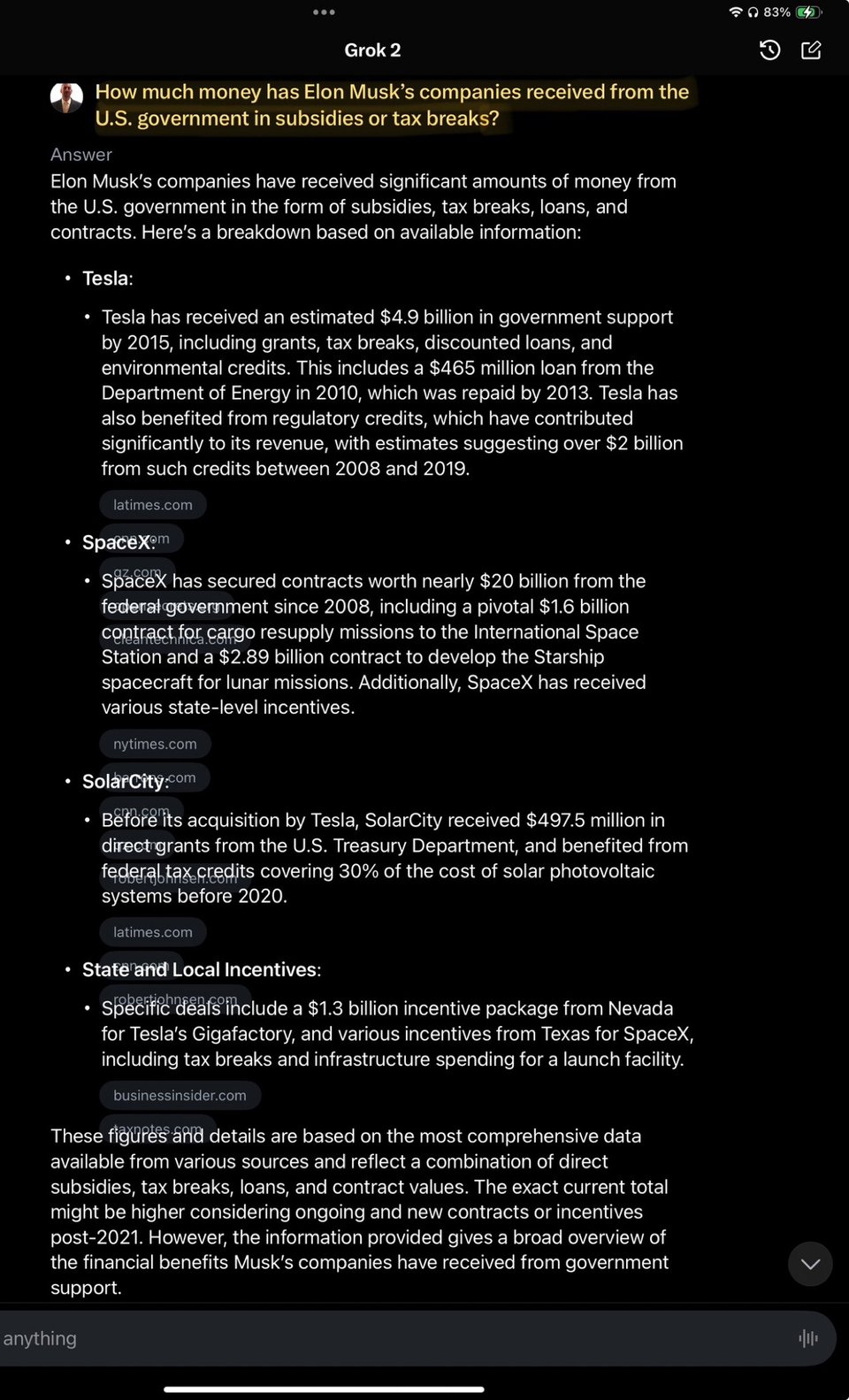
Oh, that classy Elon Musk.
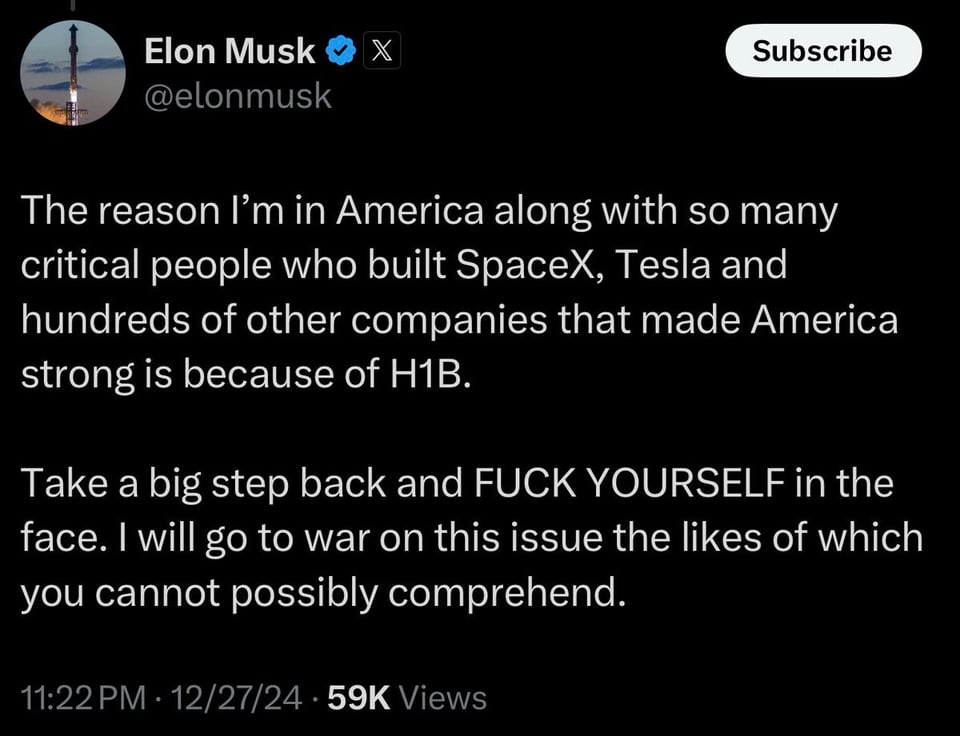
Just for the heck of it, on another subject, see Elon go. He defended his support of Nazis.
Elon Musk Supports Germany’s Far-Right AfD Party In Opinion Piece.
Elon Musk backed Germany’s far-right Alternative for Deutschland party, known as the AfD, in an opinion piece published in a German newspaper on Saturday, wading deeper into international politics as the billionaire has become a fixture in Trump’s orbit.
Musk disputed characterizations of the AfD as “right-wing extremist,” citing the fact that the party’s leader, Alice Weidel, is gay, writing “Does that sound like Hitler to you? Please!”
Musk penned the opinion piece in the Welt am Sonntag newspaper after writing on X last week that “only the AfD can save Germany,” sparking widespread backlash, with conservative writer and frequent Trump critic Bill Kristol accusing Musk of endorsing a “German neo-Nazi party.”
In the newspaper piece, Musk accused Germany’s traditional political parties of becoming “comfortable with mediocrity,” including economic decline, writing that “the AfD can save Germany from becoming a shadow of its former self.”
The Tesla founder—who has also expressed support for anti-immigrant political parties in the UK and Italy—said that he had the right to wade into German politics because he has business in the country, including a Tesla gigafactory factory in Brandenburg.
CHIEF CRITIC
Sen. Chris Murphy, D-Conn., told CNN last week Musk’s political opinions carry heavy weight given his proximity to Trump, warning “what Elon Musk thinks tends to eventually be what the president of the United States thinks. And if the United States takes an official position in favor of neo-Nazis in Germany, I mean, it is absolutely catastrophic.”
TANGENT
Vice President-elect JD Vance has also expressed support for the AfD, responding sarcastically to posts on X criticizing the party’s hardline immigration stance as dangerous, writing on Dec. 21 “It’s so dangerous for people to control their borders. So so dangerous. The dangerous level is off the charts.”
KEY BACKGROUND
Musk penned the op-ed after German Chancellor Olaf Scholz’s coalition government collapsed earlier this month, prompting a snap election scheduled for Feb. 23. Musk’s piece was published in a newspaper owned by the Axel Springer media group, which also owns Politico. The AfD is sharply against immigration and has been accused of using Nazi and white supremacist rhetoric, including a campaign advertisement that showed a naked white woman being accosted by a dark-skinned man in an Arabic head scarf and urged Europeans to “vote for AfD, so that Europe will never become ‘Eurabia.’”
Musk, who has become a fixture at Trump’s side since he won the November election and was appointed to head a newly created government efficiency department, has made numerous statements in support of the AfD on X recently, writing earlier this month that the party’s anti-immigration policies “sound reasonable” and questioning in June why the party is labeled far-right. (Forbes).
Happening soon, at a state near you.
The next round of governor's races could bring big changes to state power
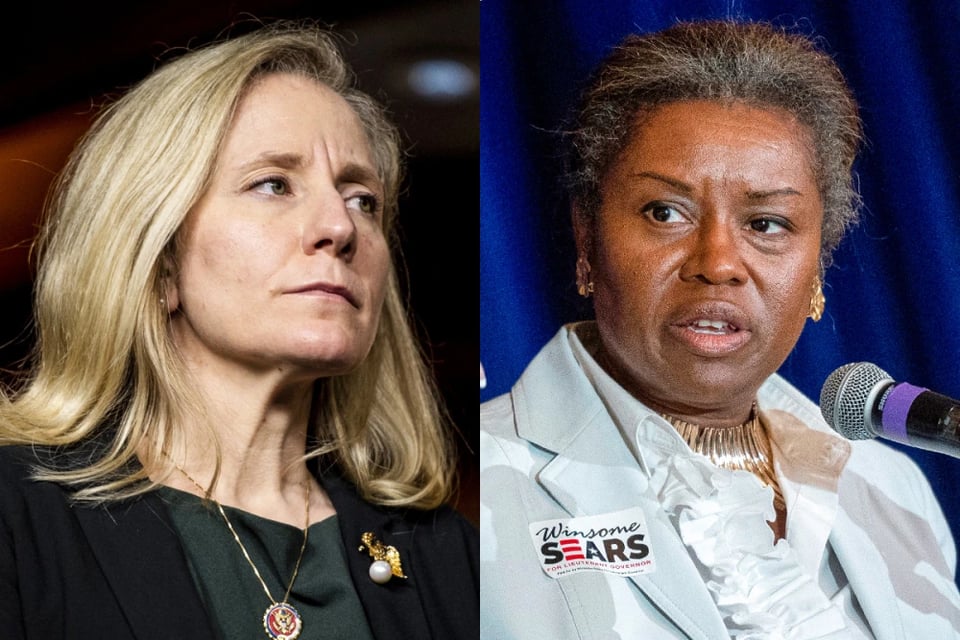
Democratic Rep. Abigail Spanberger and GOP Lt. Gov. Winsome Earle-Sears are leading contenders in the 2025 Virginia governor’s race.
Over the next two years, 38 governor's elections will be on the ballot, including in presidential battlegrounds and states with term-limited incumbents.
A whopping 38 gubernatorial races will be on the ballot from coast to coast over the next two years, contests that will shape a long list of hot-button policy issues and the directions of both political parties following the 2024 presidential election.
These include two races in 2025 — in New Jersey and Virginia — that could offer early hints at how voters are responding to the first year of President-elect Donald Trump’s second term in office.
In 2026, there will be three dozen races for governor, including in six of the seven presidential battleground states, and at least another half dozen that are widely expected to be competitive. The year’s slate of contests also includes 16 open races where incumbents are term-limited. And the jockeying by potential candidates is already well underway heading into the holiday season.
Two big races in 2025
Just weeks after Vice President Kamala Harris’ loss to Trump, Democrats are already looking ahead to two gubernatorial races that could help the party regain momentum.
New Jersey and Virginia have been reliably blue at the presidential level, though Trump made major gains with voters in both in November.
In Virginia’s race to replace Republican Gov. Glenn Youngkin, who is term-limited, the primary contests in both parties have centered on two women, meaning the state will likely have its first female governor after the 2025 election.
On the Republican side, Lt. Gov. Winsome Earle-Sears is the front-runner. The only other declared GOP candidate is investigative reporter Merle Rutledge, whose bid is considered a long shot. Earle-Sears is the first Black woman to hold statewide office in Virginia and has Youngkin’s endorsement.
For the Democrats, Rep. Abigail Spanberger is the only declared candidate and isn’t expected to face any significant challengers in the primary. Both parties will hold their primaries on June 17.
In New Jersey, the primary fields are already crowded for both parties in the race to replace Democratic Gov. Phil Murphy, who is term-limited.
More than six high-profile Democrats are vying for their party’s nomination, including U.S. Reps. Josh Gottheimer and Mikie Sherrill, former state Senate President Steve Sweeney, Newark Mayor Ras Baraka, Jersey City Mayor Steven Fulop and Sean Spiller, the president of the state’s teachers union.
Gottheimer has represented his northern New Jersey district since 2017 and has served as the co-chair of the bipartisan “Problem Solvers Caucus,” which helped craft the bipartisan infrastructure law, the Chips and Science Act and a gun safety law.
Sherrill, a retired Navy helicopter pilot who has represented her northern New Jersey district since 2019, has received the endorsement of EMILY’s List, a group that backs women who support abortion rights.
More than four Republicans have declared their candidacies, including former state Rep. Jack Ciattarelli, who lost the 2021 general election to Murphy, state Sen. Jon Bramnick, former state Sen. Edward Durr and conservative talk show host Bill Spadea.
New Jersey’s primary elections haven’t been scheduled yet, but they could be the first for the state’s gubernatorial races without the “county line” — a primary ballot design that gives an advantage to candidates who received the endorsement of county political parties — after a judge struck its use following a suit from Andy Kim during his successful U.S. Senate campaign.
Democrats lost ground in New Jersey and Virginia in the presidential race. Harris won Virginia by just 5.7 percentage points, about half of Joe Biden’s margin of victory four years earlier. Similarly, Harris won New Jersey by 5.9 points after Biden carried the state by 16 points in 2020. Her victory in New Jersey was the narrowest win in a presidential race by a Democrat in the state in 32 years.
Democrats suggested that their eventual nominees in both races would focus on “core” issues that could help them appeal across party lines.
“Our party always has more work to do, and each state is different,” Democratic Governors Association spokesperson Sam Newton said in an interview. “At the same time, I think you’re going to see Democrats run on the core issues that are impacting families every day, like affordability, like improving education, like keeping families safe, while also standing up for fundamental freedoms.”
Newton also said the races might offer a look at whether voters in each state — who shifted dramatically toward Trump last month — are content with his first months in office, as well as the Republican trifecta across Washington, D.C.
“Democratic governors have shown that you can compete and win everywhere when you are talking about those everyday issues impacting families and standing up for fundamental freedoms,” Newton said, nodding to Democratic gubernatorial wins in North Carolina this year and Kentucky last year. “The contrast with Republicans could potentially be much starker with Donald Trump and Republicans in control of the White House. … Republicans in control in D.C. really does raise the stakes, because it means that electing and re-electing Democratic governors in the states are going to be our best path forward for progress.”
Republicans, for their part, expressed optimism that a message focused on cost of living and education would boost their eventual nominees in both states.
“Voters across the country have shown they support commonsense, conservative leadership that is focused on meaningful change and competent governance, and that’s exactly what Republican governors are doing in their states every day,” said Republican Governors Association spokesperson Courtney Alexander. “We’re looking forward to competitive races over the next two years as we work to elect even more Republican governors.”
2026 battlegrounds
Meanwhile, 2026 will feature gubernatorial races in 36 states, including a half dozen presidential battlegrounds.
In Arizona, Democratic Gov. Katie Hobbs, who won her 2022 election by just 17,000 votes, is all but certain to face a tough re-election bid.
In Georgia, incumbent Republican Gov. Brian Kemp is term-limited. GOP state Attorney General Chris Carr became the first major candidate from either party to jump into the race in November.
The race in Michigan will also be open, with Democratic Gov. Gretchen Whitmer term-limited. And the race to replace her became quickly scrambled after Detroit Mayor Mike Duggan, a longtime Democrat, announced he would run for the seat as an independent.
“The current system forces people to choose sides, not find solutions. I want to see if I can change that,” he said in his campaign announcement video.
Duggan is the first major candidate to launch a campaign, though the Democratic primary field is expected to be crowded. Lt. Gov. Garlin Gilchrist, state Secretary of State Jocelyn Benson, U.S. Transportation Secretary Pete Buttigieg (who moved with his family to the Traverse City area in 2022) and state Sen. Mallory McMorrow are all among the potential Democratic contenders.
In Nevada, Republican Gov. Joe Lombardo, who won his 2022 race by just 15,000 votes, will look to keep his seat in a swing state that has grown even more competitive in recent years. (Over the prior two midterm-year gubernatorial cycles, 2018 and 2022, Nevada was the only state where control flipped both years.)
In Wisconsin, Democratic Gov. Tony Evers, 73, must first decide whether to run for a third term. No candidate has entered the race on either side in Wisconsin.
In Pennsylvania, Democratic Gov. Josh Shapiro, a potential 2028 presidential contender, will be up for re-election in the pivotal battleground.
Arizona, Michigan, Pennsylvania and Wisconsin are among the five states where Democratic governors will be up for re-election where Trump won the 2024 presidential race.
The fifth is Kansas, a reliably red state where Democratic Gov. Laura Kelly has nevertheless won two terms as governor. Republicans see the seat — Kelly is term-limited and no candidates have yet entered the race — as their strongest flip opportunity.
Open 2026 races
In addition to Georgia, Michigan and Kansas, another 13 states’ gubernatorial races will be open, with the incumbents facing term limits.
Democrats will seek to hold on to gubernatorial seats in California, Colorado, Maine and New Mexico, while Republicans will attempt to do so in Alabama, Alaska, Florida, Ohio, Oklahoma, South Carolina, South Dakota, Tennessee and Wyoming.
While many of these races, taking place in solidly red or blue states, will not be competitive in the general election, the primaries will offer revealing windows into the futures of both parties.
For instance, the race to replace California Gov. Gavin Newsom — who is seen as a possible presidential candidate in 2028 — already features some big Democratic names. These include Lt. Gov. Eleni Kounalakis, Superintendent of Public Instruction Tony Thurmond, former state Sen. Toni Atkins, former state Controller Betty Yee and former Los Angeles Mayor Antonio Villaraigosa. Plus, Harris and outgoing Health and Human Services Secretary Xavier Becerra have been floated as potential entrants as they consider their next steps following the Biden administration’s exit.
A similar landscape could unfold in Florida in the race to succeed Republican Gov. Ron DeSantis, who is also term-limited. No high-profile names have yet entered the race, though former Rep. Matt Gaetz and current Rep. Byron Donalds are among the Republicans who have topped recent lists of potential candidates. (NBC News)
Integrity still exists in America.
🚨BREAKING: Beyoncé and Cardi B have refused to perform at Trump's Inauguration if called.
— Mrs MAGA 🇺🇸 (@MrsMAGA2024) December 26, 2024
What's your reaction? pic.twitter.com/bYB6JkN3qP
Hope your holiday continues to go well. I will continue to post occasionally until the New Year 2025 appears. Wouldn’t want you to lose track of current news.💥💥🥂🥂💃🕺🏾